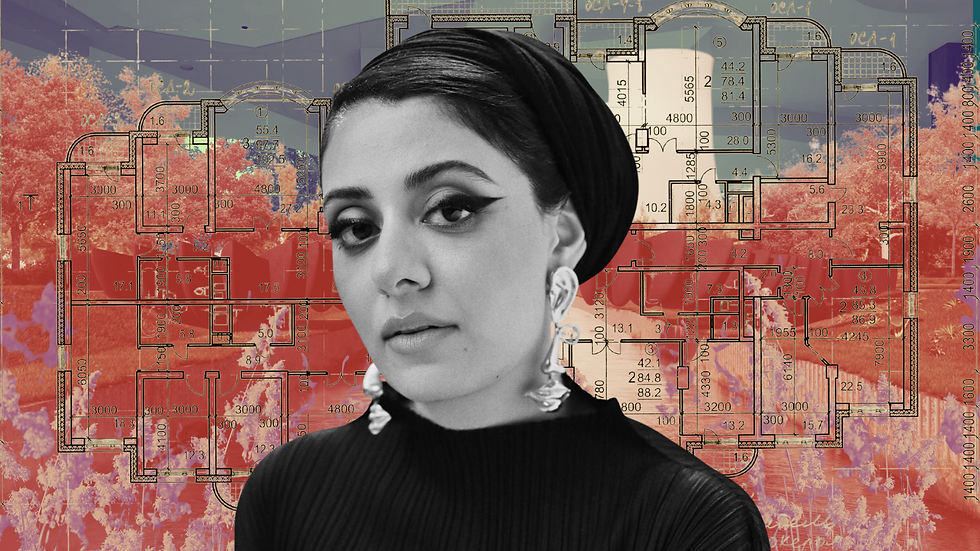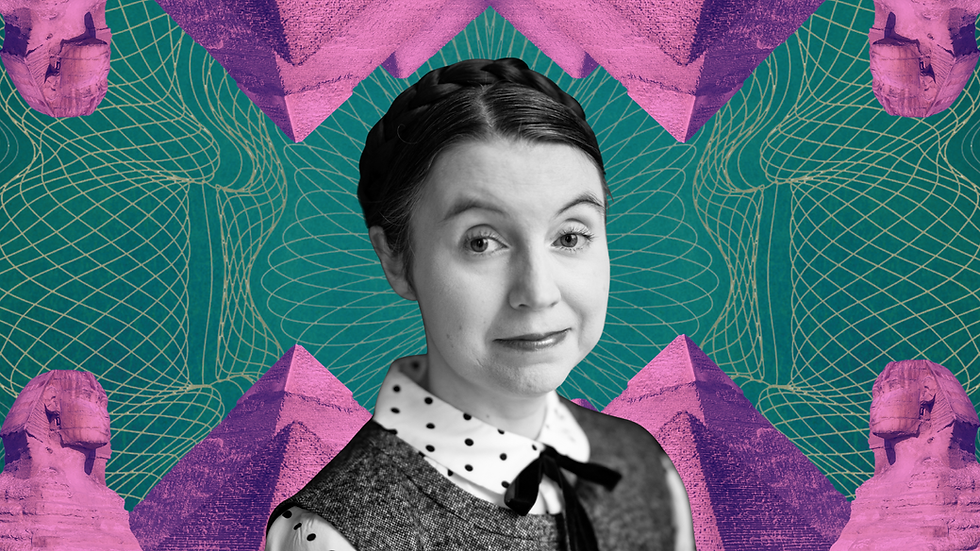Sumayya Vally: Gaza has never been allowed to grow like a normal city
- Charlotte Owen-Burge

- Aug 11
- 7 min read

Sumayya Vally is one of the most influential architects of her generation. As founder of the Johannesburg- and London-based studio Counterspace, she was the youngest architect to design the Serpentine Pavilion and has since led projects across the world, including the inaugural Islamic Arts Biennale in Jeddah. Her projects often begin with untold stories and the communities around them in order to create spaces that serve peoples’ needs and reflect their identities.
In this conversation with The Skylark, Vally reflects on the politics embedded in architecture – from the apartheid-era planning that still shapes Johannesburg to Gaza’s repeated cycles of destruction. She speaks about traditional building practices, the relationship between ecology and culture, and the role of artists in moments of political crisis, asking what it means to keep creating, and speaking, when silence is easier.

I was born and raised in South Africa. When I began to study architecture, it became impossible to unsee how deeply architecture has always been entangled in political ideologies. In South Africa, this was overt; visible in our urban fabrics, in how spaces were designed explicitly to keep us separated. We were not allowed to live among one another across race, not just by law but by design. The very structures we inhabited were crafted to enforce that.
Urban planning and architectural detail alike reflected where you sat in the racial hierarchy. The dignity you were told you deserved was directly tied to the space you were given. Architecture didn’t just reflect ideology, it perpetuated it. It helped shape our psychology. We are all born into architecture. Subconsciously, we absorb the ideas it encodes, how the world should be, where we belong, how much space we’re worth.
It’s incredibly difficult to unpick and redesign from within a system built to divide
That power still exists. Despite growing awareness around climate, segregation, and dignity, architecture as a system remains wrapped up in the politics of the opposite. It’s incredibly difficult to unpick and redesign from within a system built to divide.
Gaza has never been allowed to grow like a normal city. It’s been flattened in front of our eyes – again – but even before that, it experienced repeated cycles of war and destruction. People rebuild reactively. There’s no opportunity for incremental growth, no space for a city to evolve. And even in those reactions, the structure people respond to is shaped by ideology. The systems in place – what they have to work with – are already politicised.
I’ve seen the same thing in South Africa. Johannesburg is an incredibly opaque city – and that was intentional. It was designed to disorient, to prevent a mental map from forming, to keep people physically and psychologically separated. People have repurposed inherited structures with resilience and ingenuity, but the structures remain. Apartheid may be over, but spatial and economic apartheid are still with us. South Africa remains the most unequal country in the world.
We remain deeply unequal – and spatial planning has everything to do with that.
Of course, I feel proud of the progress we’ve made. Our constitution is among the most progressive anywhere. Ideologically, we’ve enshrined justice and dignity. But the daily lived reality doesn’t always reflect that. Economically, too, we’ve made advances. Recent US legislation has brought attention to South Africa’s economic empowerment laws, many of which aim to improve upward mobility for people of colour. But again, it’s not enough. We remain deeply unequal – and spatial planning has everything to do with that.
In apartheid South Africa, the further you were from whiteness, the further away you were placed from opportunity. Natural features and man-made infrastructure – highways, factories – were used to create buffers that kept black and brown communities distant from economic centres. To this day, people commute for hours just to reach work. How can anyone build a better life when so much of the work day is lost in transit?
And then there’s the ecological layer, which is not separate from this – it’s part of the same system. Years ago, when I was writing my master’s thesis on the psychology of segregation, I saw how it intertwined with ecological and cultural realities. Back then, it felt like a foreign concept to many. Now, thankfully, that connection is far more widely understood.
Ecology is not a separate design challenge; it’s not a problem to be solved by applying another layer. It’s a way of thinking. Our dominant worldview treats nature as a site of extraction. But other worldviews exist, and have always existed, that treat the ecological as inherent to everything. In these understandings, there is no separation between humans and the natural world.
There are so many bodies of knowledge that come from this place – across cultures, across continents – and they have enormous overlap. I often refer to the mud masons of Mali and the city of Djenné. Every year, that community re-plasters and maintains their mosque together. It’s an act of preservation through practice, not stasis. They wait for the rain, and the festival happens on the eve of its arrival. The structure breathes and shifts with the seasons. The people and the weather collaborate. That is preservation. That is living architecture.
Contrast that with the Western notion of preservation. Fixing something in time, placing it in a box, resisting change. I think of architects like Geoffrey Bawa and Minnette de Silva, who blurred the line between indoor and outdoor, whose buildings welcomed weather, rather than shielding from it. I once stayed in Bawa’s house during a monsoon. It rained inside. And that experience – the feeling, the smell – was unforgettable. Architecture has lost that intimacy with the natural world.
I know these might seem like small or romantic details, but I believe they have huge implications. In many parts of the world today, people are trying to find new ways of using water from air conditioning. In others, people historically moved when the weather changed. So maybe we should ask: should our architecture move too? Should it adapt more fundamentally to place, to season, to people?
My approach isn’t based in solutions, per se. It’s more about drawing from cultural wisdoms. Every site, every landscape holds knowledge. And that knowledge varies: floodplain to desert, rainforest to urban sprawl. But I hope I will always be learning from the land and from the people who have lived in relation to it far longer than I have.
My grandfather was sent alone, by boat, at six years old
I come from a family with a migratory history. My grandparents moved to South Africa from India just before Partition. My grandfather was sent alone, by boat, at six years old. We don’t know the full story, and the not-knowing has shaped me. That imagination, the gaps in what I can trace, informs how I work. It shows up in the projects we do, again and again, without my intending it to.

At the Serpentine Pavilion, that diasporic logic was central. We had the pavilion in Kensington Gardens, but fragments were also placed in community arts institutions across London. They became platforms for collaboration, places for radio stations and artist residencies, for new relationships to form. Sound artist Joe Namy, one of the early residents, is still running his station years later. That ongoing life, beyond the formal lifespan of the project, means something to me.
Another project I am working on is a pedestrian bridge in Belgium, that began as something simple, almost bureaucratic. But it became a cultural project once we discovered the story of Paul Panda Farnana, a Congolese activist who lived in Wilford and is now recognised as one of the most significant activists in Belgian history. As part of the bridge project, we created smaller floating structures, like pollinator boats, that move along the riverbank. Schools and community centres tend the gardens on board. They’re learning his story while nurturing new ecologies. Again, that impulse to connect across distance, to express plurality, emerges without being forced.

To me, working creatively means the personal, political and professional are always entangled. Even neutrality is a position. Even silence says something. I try to work with integrity, to stay aligned with my values, but it’s not always easy.
The times we live in challenge that alignment daily. I recently rewatched Sarafina! on Youth Day in South Africa which marks the Soweto Uprising. That uprising was led by young people protesting apartheid education policies. Police opened fire and many were killed. That day is seen as a turning point, the beginning of the end of apartheid.
The parallels with now are staggering. Today, resistance movements are again being vilified. People defending their right to exist are being framed as attackers. The encampment movements, and others, have made that stark. Sometimes I don’t know if the similarities are comforting or despairing. Maybe both. Maybe recognising the continuum gives us strength. But it also reminds us how slow change can be.
With the bridge in Belgium, we were trying in our own small way to bring justice to someone erased from history. Paul Panda Farnana’s name was almost completely lost until the 1980s. It felt important to restore that. But then I ask myself, how can I feel this deserves justice when people are suffering far worse, right now, every day?
I try to hold onto hope. Often, I find it in collaboration with people, with communities, with other architects.. It’s in those relationships that I remember what we’re working for.
These are difficult times. More and more people are self-censoring, afraid of the consequences of speaking out. But those of us who have some level of freedom, who’ve made choices that allow us to keep speaking, we have to continue. We have to create space for others to do the same.
That’s where I find a thread of hope. And I follow it.

Discover
Architecture encodes inequality
Apartheid-era planning still shapes South African cities, with Black and brown communities placed far from economic centres and opportunity.
The Development Action Group works to dismantle spatial apartheid and create inclusive urban spaces
Cities under siege can’t grow
In Gaza, over 90% of homes have been damaged or destroyed, and 1.9 million people - 90% of the population - are displaced.
Together for Palestine advocates for an immediate ceasefire, humanitarian access, and the right to rebuild
Nature and culture are intertwined
Traditional building practices, like the mud masons of Mali re-plastering Djenné’s mosque each year, show how architecture can work with the seasons and local ecology.
Architecture Sans Frontières promotes place-based, climate-conscious design
Creativity is political
Globally, over 120 million people have been displaced by conflict, disaster and climate emergency.
Choose Love supports refugees and displaced communities with emergency aid, housing, and education chooselove.org



Comments